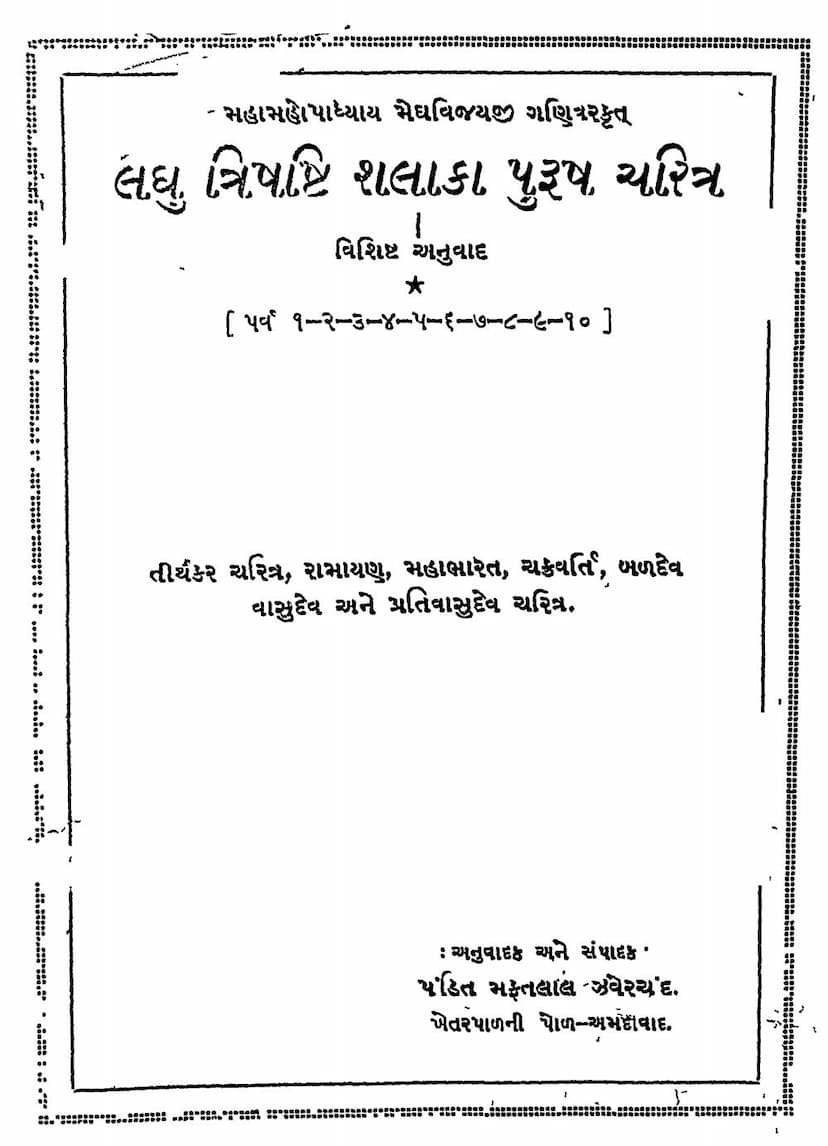Laghu Trishashti Shalaka Purush Charitra
Added to library: September 2, 2025

Summary
This document is a Gujarati translation of the Laghu Trishashti Shalaka Purusha Charitra, authored by Mafatlal Zaverchand Gandhi and published by Chotalal Mohanlal Shah. The book, cataloged at jainqq.org, aims to present a concise summary of the lives of the 63 illustrious figures in Jainism, known as the Shalaka Purushas.
The work is a translation and compilation, drawing heavily from the comprehensive Trishashti Shalaka Purusha Charitra by Acharya Hemchandracharya. The translator and editor, Pandit Mafatlal Zaverchand, embarked on this project due to the availability of a fragmented Sanskrit text and the desire to make these important narratives accessible in Gujarati.
The book details the lives of:
- 24 Tirthankaras: Including their past lives, birth events, renunciation, spiritual practices, and eventual liberation. The text highlights the lives of Rishabhdev, Ajitnath, Sambhavnath, Abhinandan Swami, Sumatinath, Padmaprabhu, Suparshvanath, Chandraprahu, Suvidhinath, Sheetalnath, Shreyansnath, Vasupujya Swami, Vimalnath, Anantnath, Dharmnath, Shantínath, Kunthunath, Aranath, Mallinath, Munisuvrat Swami, Neminath, Parshvanath, and Mahavir Swami.
- 12 Chakravartis: Monarchs who rule over the Jambudvipa continent. The text mentions Bharat, Sagar, Maghava, Sannakumar, Shanti, Kunthu, Aran, Subhum, Pavan, Harishen, Jay, and Brahmadatta as Chakravartis. It notes that while some Chakravartis achieve liberation, others may face unfortunate destinies due to their actions.
- 9 Vasudevas, 9 Baladevas, and 9 Prativasudevas: These are powerful warrior figures whose lives are intertwined with the Tirthankaras and Chakravartis. The text briefly mentions their lineage and the cycle of their conflicts.
The translation and editing process was guided by the inspiration and support of highly revered Jain monks, particularly Pandit Shrimad Charunvijayji Ganivar. The preface expresses gratitude to all contributors and patrons.
The text also includes detailed information on:
- Jain Cosmology and Philosophy: Discussing the concept of sanskar (impressions), the significance of birth in Aryavarta, the nature of Indian culture intertwined with religion, and the distinctiveness of Jainism among Indian religions. It emphasizes Jainism's preservation of its core principles amidst changes, unlike Brahmanism and Buddhism.
- The Importance of Devotion: Highlighting the central role of deities and spiritual guides in every religion, with specific mention of the veneration of Tirthankaras in Jainism.
- The Path to Liberation: Explaining how the Jiva (soul) can attain perfection and liberation through righteous conduct, contrasting worldly pleasures with spiritual liberation.
- The Significance of the Trishashti Purusha: The 63 great souls are presented as exemplars of spiritual and worldly accomplishment, with their stories illustrating the principles of karma, dharma, and liberation.
The text provides birth charts and astronomical details for some of the Tirthankaras, and details the spiritual journeys of prominent figures like Rishabhdev, Ajitnath, Sambhavnath, Abhinandan Swami, Sumatinath, Padmaprabhu, Suparshvanath, Chandrapabhu, Suvidhinath, Shitalnath, Shreyansnath, Vasupujya Swami, Vimalnath, Anantnath, Dharmnath, Shantínath, Kunthinath, Aranath, Mallinath, Munisuvrat Swami, Neminath, Parshvanath, and Mahavir Swami. It also details the lives of the Chakravartis and the Vasudevas, Baladevas, and Prativasudevas.
The book's primary aim is to educate and inspire readers by presenting the epic lives and teachings of these significant figures within the Jain tradition, emphasizing the principles of righteousness, non-violence, and the pursuit of spiritual liberation.